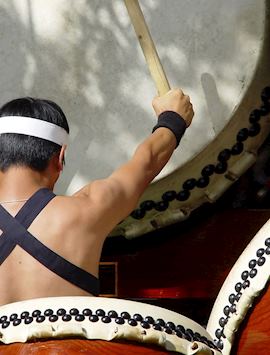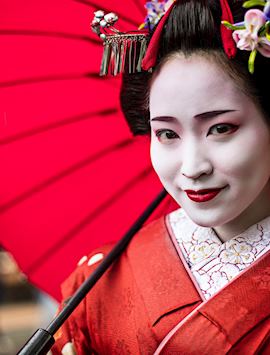At 12,400 feet (3,776 m), Mount Fuji is the tallest mountain in Japan and its near symmetrical-shaped cone has attained an almost mythical status.
It is one of Japan's three holy mountains and was first ascended by a monk in 663, with women being forbidden to climb it until the Meiji Era, in the late 1800s. The volcano is now dormant and last erupted in 1708.
Mount Fuji, or Fuji-san, as it is more commonly known in Japan, has been the subject for many artists over the years, from the famous "ukiyo-e" woodblock prints of Hokusai to being printed on the back of a JPY 1,000 note.
Since its first recorded depiction on a sliding door in the 11th century, the iconic image of Mount Fuji has been used to decorate commemorative stamps, incense holders, lacquerware boxes, ceramics, clothing, and painted scrolls, to name but a few.
Start planning your trip to Mount Fuji
Start thinking about your experience. These itineraries are simply suggestions for how you could enjoy some of the same experiences as our specialists. They're just for inspiration, because your trip will be created around your particular tastes.
View All Tours in JapanLocations to view Mount Fuji
Tokyo
On a clear, crisp day, from some of the taller skyscrapers in the city, including several luxury hotels, Tokyo Tower and the Tokyo Metropolitan Government Buildings, Mount Fuji can be seen in the far distance.
It can also be seen when you take the bullet train route between Tokyo and Kyoto, from the right hand side of the carriage, if you are traveling south from Tokyo.
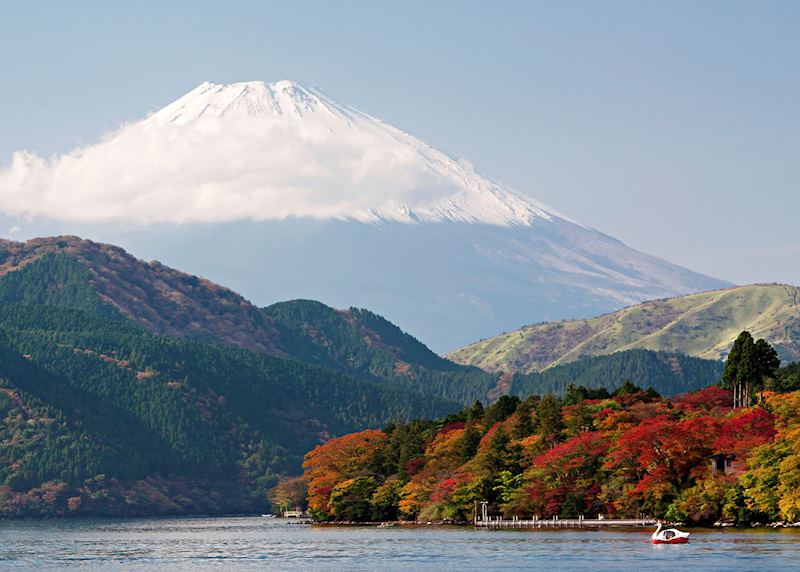
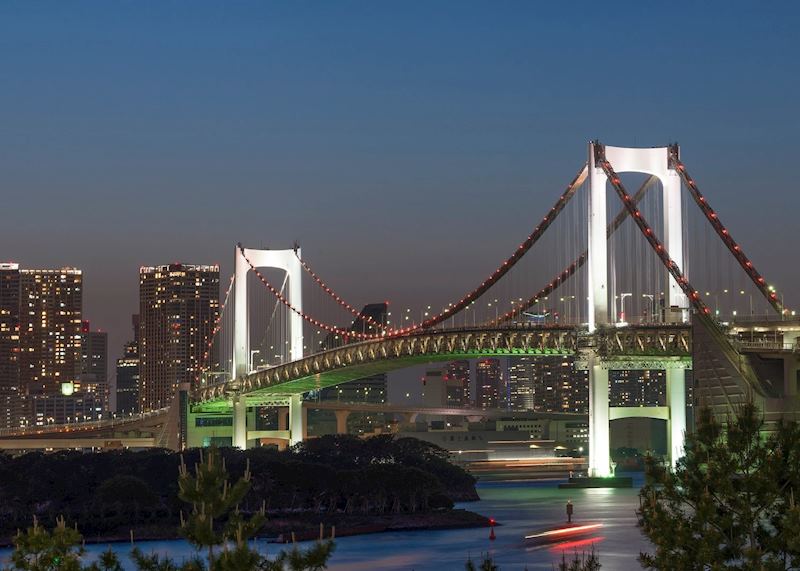
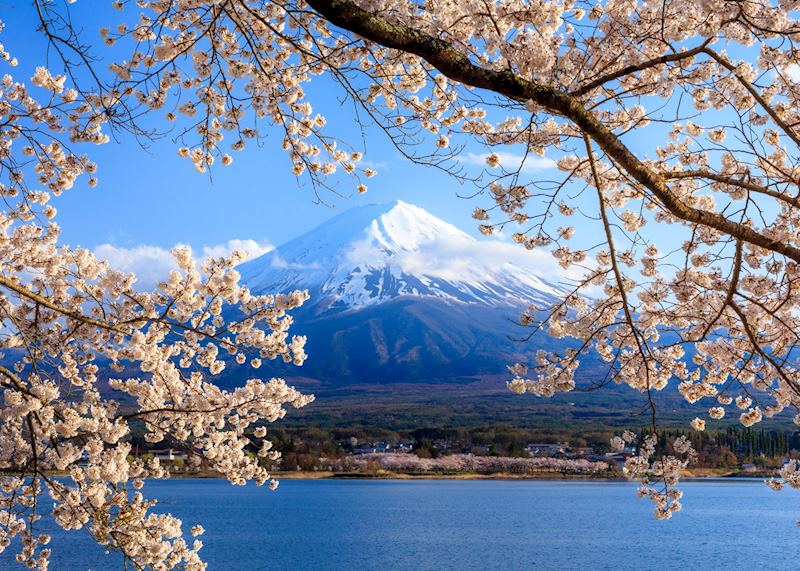
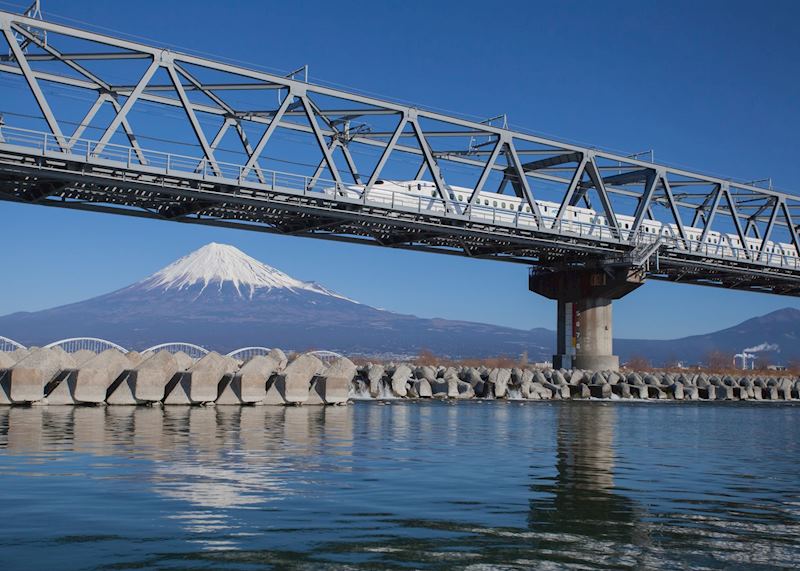
Hakone National Park
Situated less than two hours from Tokyo and accessible by bullet train and private line trains, the Hakone National Park is an area of natural beauty, volcanic and thermal activity and weather permitting, an ideal spot from which to view Mount Fuji.
Most visitors to Hakone adopt a standard circular route around the park, which can be enjoyed over a couple of days. The loop is serviced by various modes of transport, including a cable car, switch-back mountain trains, a ropeway and even a lake crossing on a mock pirate ship.
The park is also home to some first rate museums, including the Open Air Sculpture Museum and Pola Museum, both of which warrant a visit during a stay in Hakone.
The mountains of this region, including Mount Fuji, mean that Hakone is blessed with an abundance of hot spring waters, many of which have been funneled into traditional ryokan to be used in private open air baths, or the communal baths for use by guests.
Fuji Five Lakes (Fuji go ko)
Located at the foot of Mount Fuji, in Yamanashi Prefecture, this region is one of the most scenic spots from which to view the mountain.
Hundreds of years ago, pilgrims to Mount Fuji first visited the Sengen Jinja shrine near to the town of Fuji-Yoshida and then climbed the remaining 11 miles up to the summit, walking among towering cedar trees, old stone lanterns and lush forests before reaching the rockier enclaves higher up the mountain.
The region is home to five, clear-water lakes (hence the name of the area), with Kawaguchi-ko being the most accessible. There are good views of Mount Fuji from the lake, particularly on the northern shore. Most of the accommodations are located to the southeast side of the lake.
Shizuoka
Claiming to be the home of Mount Fuji, Shizuoka prefecture lies to the south of the Fuji-Izu-Hakone National Park and boasts some spectacular viewing points of the peak, particularly around the Asagiri Highlands, Lake Tanuki and Fujinomiya City.
There are also lots of outdoor activities available in the area, many of which are suitable for families.
Climbing Mount Fuji
Today, Mount Fuji is a popular peak to climb, both for experienced mountaineers and first time climbers, although there is a saying in Japanese that 'a wise man climbs Mount Fuji but only a fool climbs it twice!'.
Over 200,000 people attempt to climb the mountain each year and with the official climbing season lasting only from the beginning of July through to the end of August, the ascent can become very busy at peak times.
Climbing Mount Fuji should not be undertaken lightly. The reward for reaching the top may be tempered by the sheer volume of crowds making the climb with you and with much of the trail being loose scree and steep scrabbles along rocky paths, climbing can be hard-going at times.
Accommodations on a climb are in basic, communal huts, with some night climbs to time the ascent to the summit with a beautiful sunrise. It takes around five to eight hours to reach the summit from the large 'fifth station' start point, but there are several different areas from which to begin the hike and these can affect the climb time.
If you wish to admire the peak from the bottom up, there are several areas around the base of the mountain and surrounding national park, which offer spectacular views, gentler hiking routes and open air hot spring baths from which to admire the majesty of the mountain.

